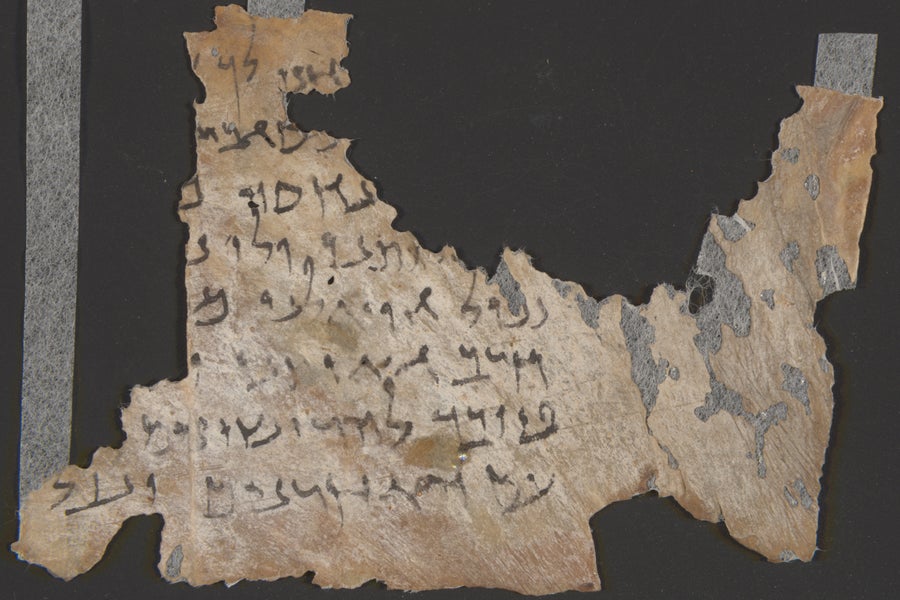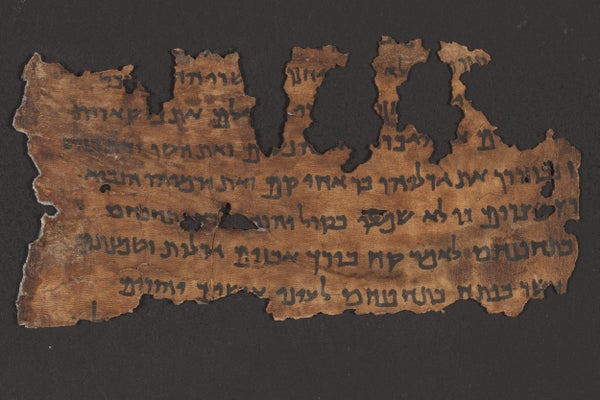The scenario might sound like the opening line of a science-themed comedy routine: a molecular biologist and a Bible scholar meet on a bus. Eight years after that encounter the two have developed a new technique using DNA sequencing that they say will enable them to match—or separate—minuscule fragments of the 2,000-year-old Dead Sea Scrolls.Their research was published on Tuesday in Cell.
Oded Rechavi investigates inheritance in the nematode worm Caenorhabditis elegans, and Noam Mizrahi studies ancient Hebrew literature. Both researchers are at Tel Aviv University, and in 2012 they sat beside each other on a busduring an orientation program for new faculty hires. United by a common interest in worms (“Oded works on microscopic C. elegans worms, and I’m working on what worms have left us," Mizrahi quips), the pair subsequentlydecided to collaborate.
Now their innovative DNA-fingerprinting method—which used carefully sequenced ancient cow and sheep DNA scraped from the backs of bits of animal-skin-based parchments among the Dead Sea Scrolls—is offering new insights into the social fabric of the Essenes, the ascetic Jewish sect widely believed to have written the scrolls. And this sensitive “paleogenomic” technique could be employed to piece together other fragmentary ancient texts in the future, Rechavi says.
On supporting science journalism
If you're enjoying this article, consider supporting our award-winning journalism by subscribing. By purchasing a subscription you are helping to ensure the future of impactful stories about the discoveries and ideas shaping our world today.
“The use of DNA fingerprinting to help us place small pieces of longer texts in their rightful context is extremely exciting and important,” says Charlotte Hempel, a professor of the Hebrew Bible and Second Temple Judaism at the University of Birmingham in England, who was not involved in the new study.Oren Harman, a historian of science at Israel’s Bar-Ilan University, who was also not involved in the research, concurs. “We can suddenly see things that were not visible using more traditional historical, archaeological or literary sources,” he says.

Fragment of Scroll Hev/Se6: A prayer text, originally thought to be from the Wadi Seiyal site but probably found in the Nahal Hever site. Credit: Shai Halevi and Leon Levy Dead Sea Scrolls Digital Library, Israel Antiquities Authority
The Dead Sea Scrolls, written between the third century B.C. and the first century A.D., were discovered between 1947 and 1956 in 11 caves near Khirbat Qumran in the West Bank, on the northwestern shores of the Dead Sea. Most of the scrolls—which comprise the oldest known versions of the books canonized as part of the Hebrew Bible, as well as apocrypha and mystical liturgical texts—were inscribed in Hebrew. A small number were written in Aramaic or Greek. Only a few were found intact. The rest had disintegrated into fragile scraps, around 25,000 in total, according to the paper.
Researchers have tried for decades to piece together the ever growing heaps of fragments, which were initially stored at the Rockefeller Archaeological Museum in eastern Jerusalem. Sometimes scientists even stuck them together with tape,Mizrahi says. Matching up the pieces, he adds, “is a major challenge with which we still struggle.”
For the new study, Mizrahi and Rechavi focused on 40 to 50 artifacts, including scroll fragments whose origins are ambiguous. Molecular biologist Sarit Anava, who is lab manager for Rechavi’s team, traveled several times to Uppsala University in Sweden carrying samples authorized by the Israel Antiquities Authority, the custodian of the scrolls. There, in the clean rooms of Mattias Jakobsson’s lab, she extracted ancient DNA from 26 different fragments, as well as leather items, including sandals, a garment and water skins from the Qumran region. “Then we had the long task of trying to make sense out of what she sequenced,” Rechavi says.
The researchers’ first step was to use the DNA sequences to identify the species of animals—goats, sheep, ibex or cows—whose skin was used to make the parchment. Virtually all the scroll samples in the study, they found, were made from sheep skin. A few, however, were made from cow hide. The team says this finding offers important insights into the scrolls’ history. For example,scholars had debated whether three fragments of the Book of Jeremiah had belonged to the same scroll. A genetic analysis indicated that one fragment was made from cow skin and that the other two were made from sheep skin. Because cattle husbandry is widely considered to be impossible in the dry Judaean Desert surrounding Qumran (cows require large quantities of grass and water), the former fragment—along with a separate cow-hide piece of the same book—probably originated outside the area, Mizrahi says.
“Even more importantly,” he says, “these two fragments written on cow skin represent two different versions of the Book of Jeremiah.” Mizrahi and Rechavi claim their DNA analysis offers the first “hard proof” that the Essenes, and Jewish society at the time in general, were more open to varying texts than many are today—when only one virtually identical Hebrew biblical text is read by most Jewish communities everywhere in the world.“If these scrolls were brought from outside," Mizrahi says, “it shows that Jewish society of the Second Temple period was not ‘Orthodox.’ They were open to the parallel existence of multiple versions of the very same divinely inspired text of the prophets.”
The new DNA technique holds promise that extends beyond the cultural implications, explains Eibert Tigchelaar, a specialist in the Dead Sea Scrolls and ancient Judaism at KU Leuven in Belgium, who was not involved in the study. “There are some 20 to 30 literary works of which we have many fragments without knowing how to arrange them in their original order,” he says. “The new technique provides important evidence that will serve as a major step for the reconstructing of these manuscripts. Technically, one could sample the DNA fingerprints of large amounts of fragments, thus creating a database, which could assist in the identification of at least some of the few thousand of hitherto unidentified fragments.”
Rechavi and Mizrahi’s findings also represent a win for their unusual interdisciplinary approach. Together, Mizrahi says, “we created a new set of extremely sensitive scientific tools for the study of ancient artifacts.” To top it off, Rechavi adds,“this is the most fun collaboration I ever had by far.”
